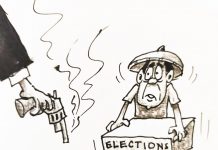The acquisition of government permits in this country feels like crawling through barbed wire—painful, slow, and full of hidden traps. What should be a straightforward process has mutated into a grueling obstacle course layered with redundant paperwork, delayed signatories, and the smug faces of people who know they hold power over your every next step.
The list of requirements alone reads like a cruel joke. One document demands another, which in turn requires a separate clearance from an office across town—each with its own set of signatures, fees, and arbitrary cut-off times. For ordinary folk who just want to run a small business, build a modest home, or apply for something as basic as a barangay clearance, it’s a bureaucratic purgatory.
And then comes the darker part—the part everyone knows but hardly anyone wants to talk about. Corruption doesn’t sit in some far-off high office. It lurks in the everyday desk drawers of permit offices. There are whispers, side glances, and “pa-kape lang” suggestions. I have seen it, heard it, been hinted at. A man trying to secure a permit for his eatery was told to come back “next week” unless, of course, he wanted to “speed things up.” A small brown envelope, discreetly passed, magically cleared a week’s worth of pending signatures in under ten minutes. You either play the game or wait indefinitely.
It’s no wonder people skirt around the process. Who would want to suffer through a maze only to be asked for grease money at the final door? I know families who opt not to register their backyard businesses because they’d rather not deal with the exhaustion. I know sari-sari store owners who quietly operate without full documentation, fearing not the law, but the paper chase and the draining transactions with fixers who feed off the helplessness of the uninformed. This avoidance isn’t born out of laziness—it’s a defense mechanism, a quiet protest, and sometimes, a desperate attempt to protect their already limited resources.
We can’t keep blaming the public for “non-compliance” when the system itself is often hostile, opaque, and unreasonably rigid. Try asking an office why they need a particular clearance, and you’ll either be met with a shrug or a stern “requirement po ’yan.” No explanation, no rationale—just blind obedience to forms. It feels like some requirements exist only to create jobs for more people who shuffle papers and sign things without accountability. In truth, the system doesn’t serve the public anymore. It serves itself, bloated and unbothered by the suffering it causes.
Meanwhile, those with connections skip the lines. They make one phone call and everything falls into place like dominoes—no queues, no waiting, no interrogations. It’s a parallel universe where things move with suspicious efficiency. And while the rest of us are drowning in photocopies, certified true copies, and vague requirements, the privileged few are waved through like royalty. This dual reality is one of the most painful truths of our governance: fairness exists only in speeches, not in practice.
What makes this even more frustrating is that we have the tools to fix this. Technology can automate clearances, reduce human interaction, and prevent bribery—but it remains underutilized or worse, corrupted too. A few LGUs have started to roll out digital platforms for permits, but the implementation is often half-baked, crashing mid-transaction or demanding in-person validation anyway. Instead of convenience, people are met with more confusion. It’s the illusion of progress without the reality of change.
What we need is not just simplification, but a cultural shift in how the government sees itself—not as a fortress to be approached with fear, but as a service provider to ordinary citizens. The paperwork must shrink. The explanations must flow. The processes must be transparent, timed, and free from the shadows of corruption. People will comply—not out of fear, but out of trust—if we finally build a system that serves, not swindles.




